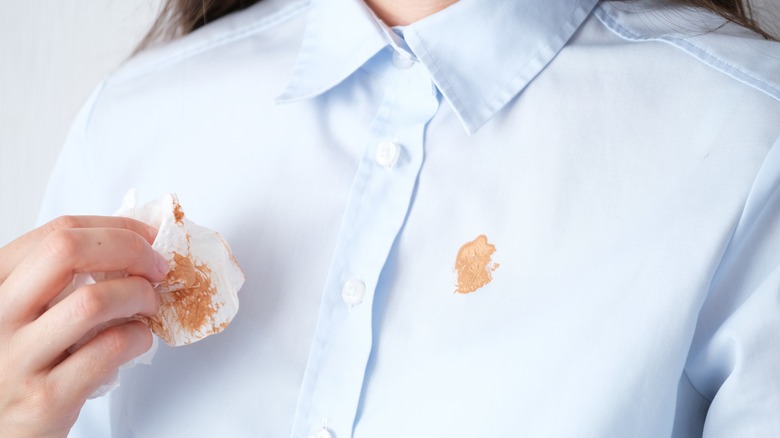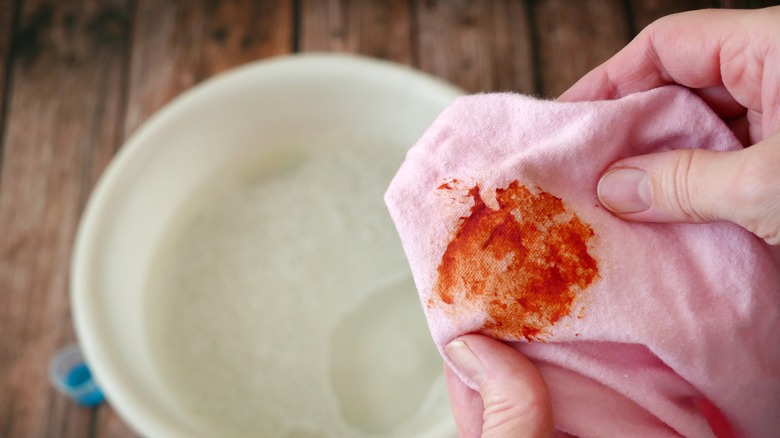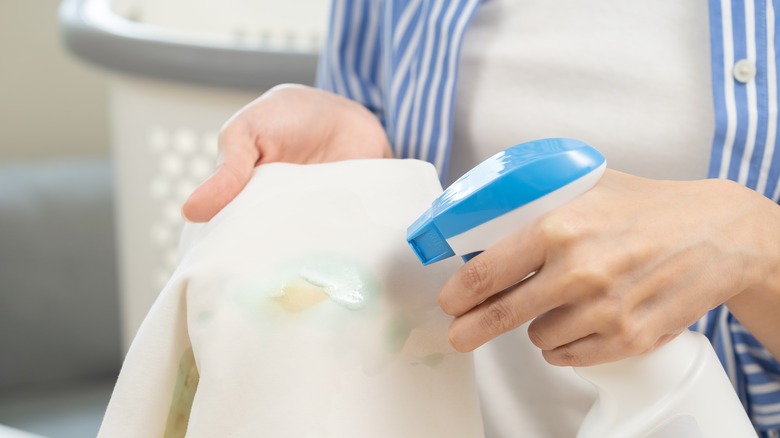Prevent Laundry Stains From Getting Worse By Knowing When To Rub Vs. Dab
We may receive a commission on purchases made from links.
Laundry stains are frustrating, but what's even more upsetting is when you unintentionally exacerbate the situation by rubbing it in while frantically trying to clean up the mess. You're not alone in this either — one of the most common laundry mistakes that makes stains worse is when you rub it in, rather than dabbing at it. It's best to avoid rubbing at laundry stains because rubbing can damage the fabric, which can cause the stain to further penetrate the material. One of the only times it is acceptable to rub rather than blot is when you're rubbing something in to lift the stain, like a baking soda paste.
In addition to considering when you should rub instead of dab, using the incorrect water temperature when dealing with laundry stains can also make them much worse. Depending on the type of stain and the material of the fabric you're trying to wash, the water temperature you should use for stain fighting will vary. For instance, when dealing with bloodstains, you should use cold water, but with berry stains, you need to use cold water before hot. And, no matter what type of laundry stain you're dealing with, or what your cleaning approach is, you should always treat it as quickly as possible. The longer a stain sits, the more challenging it will become for you to remove it.
When to dab at laundry stains (and how to do it properly)
Depending on the type of stain you're dealing with, you may want to soak the rag you're using before you begin dabbing. For example, if you're working on a stain that is best treated with cold water, you can first soak the rag in cold water before dabbing. Some of the tougher laundry stains that you should treat with cold water come from grass stains, water-based paint, and eggs. For stains that you can treat with hot water, you'll follow the same process as if you were using cold water. You can also soak the fabric in hot water if the material is able to handle it. Stains that you can treat with hot water include oil, grease, lotion, and foundation. The material of fabric you're dealing with also influences what water temperature you should use. Cold water is typically better when you're working with delicate and natural fabrics, and hot water is better suited for synthetic fabrics.
Now that we've covered when to dab at stains, let's talk about how to do it properly. The key is to not dab at the stain too aggressively. Instead, you should gently blot at the stain with a clean towel. This will help absorb the spill, and prevent it from spreading. Try to absorb as much of the spill as you can, but be sure to take your time with this and do it gently to avoid damaging the fabric. You should also dab at the stain from the outside in, and make sure that you're using the entire cloth to make sure you're not accidentally spreading the stain around.
When it's okay to rub at a laundry stain
There are really only two scenarios in which you'll rub at a laundry stain. The first is when you spill or have a glob of something, like butter or mud, on your laundry. In this case, you definitely want to wipe off as much of the residue as possible. To be clear though, you should be wiping residue off, rather than rubbing it in, so be extra careful with this process.
The other circumstance in which it might be acceptable to rub at a laundry stain is when you're pretreating it. This could be with a baking soda paste or an enzyme stain remover from Amazon for $3.48. For example, a paste of baking soda can help you banish paint stains and grass marks from your laundry, and the best way to apply it is to massage the paste directly into the affected area of the fabric. The process is the same when using enzyme stain removers for removing stains like oil and grease — you can help coax the stains out of the fabric by rubbing enzyme stain removers or detergent directly into the stain. Be sure that this process takes place after you've done the initial soaking or blotting to avoid accidentally setting the stain.


